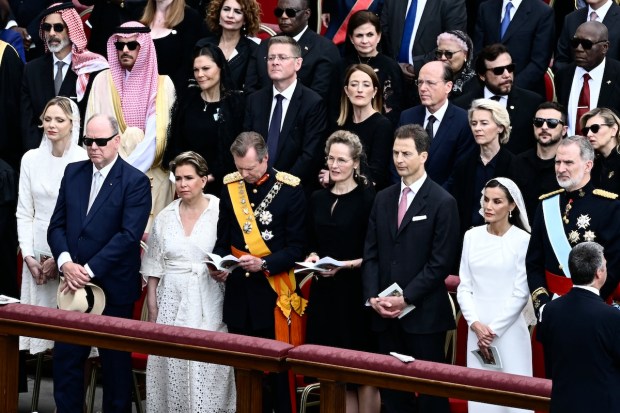From Aleteia
As the sun rose over St. Peter’s Square on May 18, 2025, a sea of black-clad dignitaries gathered to witness the inaugural Mass of Pope Leo XIV. Yet among the solemn procession of world leaders and royals, a few women stood out — dressed not in traditional black, but in resplendent white. Their presence was not only striking but deeply symbolic, a living expression of an ancient protocol known as the privilège du blanc — the privilege of the white.
This rare privilege is enjoyed by only a select group of Catholic queens and princesses, allowing them to wear white in the presence of the pope. Traditionally long-sleeved dresses in white, often paired with a matching mantilla, distinguish these royal women from their peers. Others, including non-Catholic royals, are expected to wear similar attire in black — a symbol of humility and respect. Those from countries with their own traditional dress might be in their own colors.
Their appearance was a quiet yet powerful testament to their faith and the centuries-old bond between the Catholic Church and royal houses across Europe.

In contrast, Crown Princess Victoria of Sweden, a member of the Lutheran Church, arrived in black. Queen Máxima of the Netherlands, although a practicing Catholic, did the same. Despite her faith, she would not be part of the privilege due to her marriage into the Dutch royal family, which is historically Protestant. Moreover, her daughters are being raised in that tradition, aligning the family’s religious stance with national heritage.
Currently, only seven royal women enjoy the privilège du blanc: Queen Sofía and Queen Letizia of Spain; Queen Mathilde and Queen Paola of Belgium; Grand Duchess Maria Teresa of Luxembourg; Princess Charlene of Monaco; and Princess Marina of Savoy.
Interestingly, Princess Charlene’s right to wear white is a more recent development. When she married Prince Albert II of Monaco in 2011, it wasn't clear if she would enjoy the privilege. It was only in 2013, following a private audience with Pope Benedict XVI, that her white was seen sparkling.
By contrast, Princess Grace, Charlene’s iconic predecessor, did not use the same privilege during her meetings with Popes Pius XII, John XXIII, and John Paul II.
A little Spanish flair
For the Spanish queens, the white mantilla sometimes comes with an added flourish: the peineta, a traditional Spanish comb worn beneath the lace, at the back of the head. Queen Letizia, however, has chosen this elaborate headpiece only once — at her 2004 visit with Pope John Paul II. Since then, she has opted for a simpler mantilla, as did Queen Mathilde and Grand Duchess Maria Teresa during the inauguration.
Though modern protocol at the Vatican is increasingly relaxed — Queen Elizabeth II famously wore lavender in her meeting with Pope Francis — the privilège du blanc remains a potent symbol. It’s not merely a matter of attire, but a visible expression of fidelity, purity, and a shared spiritual heritage between the Catholic Church and faithful monarchies.
As Pope Leo XIV begins his papacy, these women in white offered a moving visual reminder: amid changing times, some traditions still speak volumes.

No comments:
Post a Comment
Comments are subject to deletion if they are not germane. I have no problem with a bit of colourful language, but blasphemy or depraved profanity will not be allowed. Attacks on the Catholic Faith will not be tolerated. Comments will be deleted that are republican (Yanks! Note the lower case 'r'!), attacks on the legitimacy of Pope Leo XIV as the Vicar of Christ, the legitimacy of the House of Windsor or of the claims of the Elder Line of the House of France, or attacks on the legitimacy of any of the currently ruling Houses of Europe.